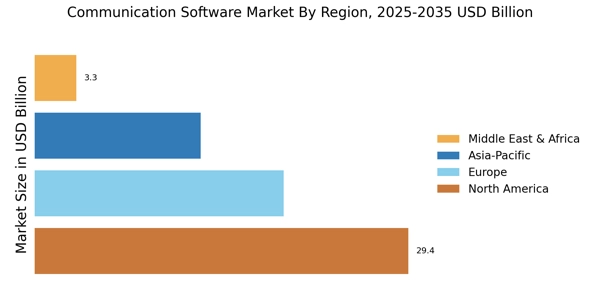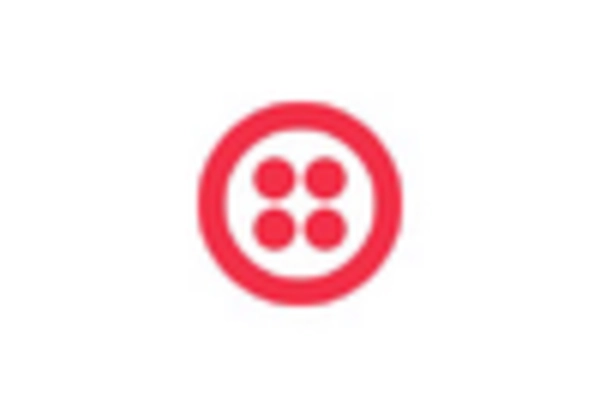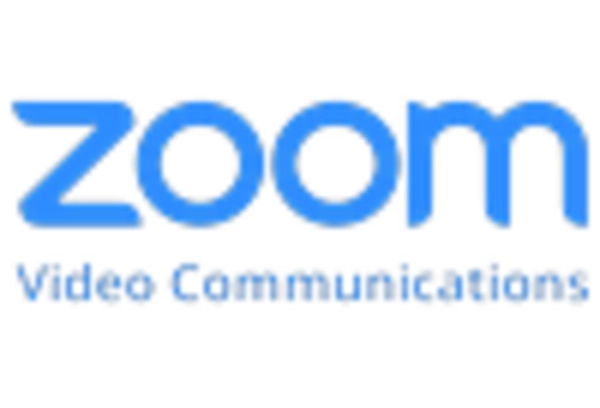Integration with Emerging Technologies
The Communication Software Market is witnessing a significant trend towards integration with emerging technologies. As businesses seek to enhance their communication capabilities, they are increasingly adopting tools that leverage artificial intelligence, machine learning, and automation. These technologies enable features such as intelligent chatbots, automated scheduling, and advanced analytics, which streamline communication processes. Market analysis suggests that the integration of AI-driven features could potentially increase user engagement by up to 30%. This trend not only improves the user experience but also allows organizations to derive actionable insights from communication data. As a result, the Communication Software Market is likely to see continued innovation as providers strive to incorporate these advanced technologies into their offerings.
Increased Focus on Data Security and Privacy
In the Communication Software Market, there is an escalating emphasis on data security and privacy. As organizations become more aware of the risks associated with data breaches and cyber threats, they are prioritizing communication tools that offer robust security features. Recent statistics indicate that nearly 70% of businesses consider security a critical factor when selecting communication software. This trend is further amplified by regulatory requirements that mandate compliance with data protection laws. Consequently, software providers are investing in advanced encryption technologies and secure authentication methods to meet these demands. The Communication Software Market is thus evolving to incorporate security as a core component, ensuring that users can communicate confidently without compromising sensitive information.
Expansion of Mobile Communication Applications
The Communication Software Market is witnessing an expansion of mobile communication applications. With the proliferation of smartphones and tablets, there is a growing expectation for communication tools to be accessible on mobile devices. Recent data shows that mobile communication applications account for over 40% of the total communication software market. This trend is driven by the need for on-the-go access to communication tools, enabling users to stay connected regardless of their location. As a result, software developers are focusing on creating mobile-friendly applications that offer the same functionality as their desktop counterparts. The Communication Software Market is thus evolving to meet the demands of a mobile workforce, ensuring that users can communicate effectively anytime, anywhere.
Growing Need for Unified Communication Solutions
The Communication Software Market is experiencing a growing need for unified communication solutions. Organizations are increasingly recognizing the benefits of consolidating various communication channels into a single platform. This approach enhances efficiency by reducing the complexity associated with managing multiple tools. Recent surveys indicate that over 60% of companies prefer integrated solutions that combine messaging, video conferencing, and file sharing. By adopting unified communication systems, businesses can improve collaboration and streamline workflows, ultimately leading to increased productivity. The Communication Software Market is thus adapting to this demand, with providers developing comprehensive solutions that cater to the diverse communication needs of modern organizations.
Rising Demand for Remote Communication Solutions
The Communication Software Market is experiencing a notable surge in demand for remote communication solutions. As organizations increasingly adopt flexible work arrangements, the need for effective communication tools has become paramount. According to recent data, the market for communication software is projected to grow at a compound annual growth rate of approximately 12% over the next five years. This growth is driven by the necessity for seamless collaboration among distributed teams, which has led to a heightened focus on software that facilitates real-time communication. Furthermore, businesses are seeking solutions that integrate with existing workflows, enhancing productivity and efficiency. The Communication Software Market is thus positioned to benefit from this trend, as companies prioritize tools that support remote work and foster collaboration across geographical boundaries.


















Leave a Comment